|
So here we are at the dawn of 2025, finally rid of a deeply corrupt and increasingly destructive
Conservative rule of 13 long bloody years, but facing an uncertain and potentially grim future nonetheless because of the bemusing and potentially catastrophic re-election of Donald Trump in the USA. This would usually be my cue for a long and angry rant, one that would include more complaints about the increasing harm to democracy and truth being done by the turd on a stick that is Elon fucking Musk, who is now calling for America to invade the UK and overthrow our democratically elected government, about which he is spreading the sort of lies that end up getting people killed. Never forget that the man who murdered Labour MP Jo Cox – a genuinely compassionate politician who was fully committed to her calling – was fired up to do so by the sort of fascist rhetoric exposed by the currently incarcerated criminal that Space Karen would like to see running this country instead. And with Trump continuing to blag on about taking Greenland and the Panama Canal for America, by force if necessary, as well as wanting to make Canada the 51st state of the US (yeah, good luck with that, fucko), it’s hard not to fear for the horrors that 2025 has yet to unleash. It’s also becoming increasingly difficult to get to the truth when the news narrative is controlled by a small number of amoral oligarchs who would willingly sacrifice the vast majority of the world’s population if they thought it could make them a few more bucks to throw on a pile of cash that’s already so large that it could reach into space and circle the moon.
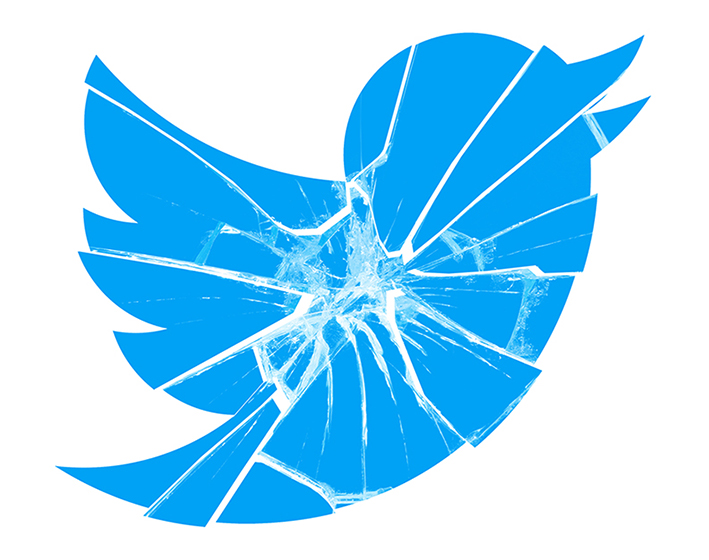
With Musk now the most dangerous threat to democracy worldwide, I made the decision to shut down both the Cine Outsider and my own accounts on Twitter, which under Musk’s misrule has become a cesspool of right-wing lies and hateful bigotry. Then, just a couple of days after I had done so, Mark bloody Zuckerberg bent over and spread his cheeks for Trump by announcing that he was removing fact checkers from Facebook with the ludicrous claim that they were regarded as biased. By whom? I’ll give you three guesses. This is where we are now, correcting lies and misinformation by citing factual evidence apparently makes you biased. Of course, this may well seem to be the case if you lean to the right, but that’s because right-wingers tell so many blatant lies, and Elon Musk is now their self-appointed liar in chief. What this means is that Facebook, Instagram and Threads are all likely to now dive headlong into the same racist, misogynistic and conspiracy theory rabbit hole into which Twitter long ago fell. And this seems to be by deliberate design, as those with the patience to read through Meta’s new moderation policies have discovered. While it is still forbidden to call someone mentally ill on Zuckerberg’s platforms, for example, it’s now perfectly fine to do so if the insult is directed at anyone from the LGBTQ community. Apparently it’s all about “free speech” and “public discourse.” Yeah, we have another term entirely for it, one that Meta would undoubtably ban it posted it on our Facebook page. I wonder long it will be before I have to take that down as well. There’s so much I could talk about in regards to where the world appears to be heading and whether we’ll be continuing this discussion in a year’s time or reduced to atoms, but there are a lot of films to cover here, and my time is more restricted now I’m back at work after a welcome break, so I’ll put all that on hold and focus on the task in hand.
For the site, 2024 was an interesting but difficult and at one point genuinely terrifying year, with my own ability to deliver reviews hampered once again by sudden surges in my daytime job workload, and earlier in the year by a serious medical emergency that landed my long-time partner in hospital and at one point seemingly fighting for her life. The drug regime prescribed by an infectiously confident specialist slowly bore fruit and stabilised her condition, eventually to the point where she was back to being the person she was before her health so dramatically deteriorated. Hoorah, once again, for the NHS, the rebuilding of which after years of Tory rundown absolutely should be a priority for a Labour government that really needs to start getting its act together, and also hire someone to handle its comms who doesn’t have their head stuck halfway up their rectum.
As I’ve gotten older, my mental acuity has certainly hit a few walls, and writing reviews certainly takes me considerably longer than it used to when I was in my 30s and 40s. Even typing the buggers out is fraught with problems these days, as my stupid fingers now repeatedly seem to miss their target, hitting the wrong keys and/or catching one of the adjacent ones, requiring me to pause every few words to correct all of the resulting errors. Long hours of work when he has secured editing jobs have made it difficult for Camus to contribute as much as he has in past years, while one of our other reviewers was taken out of the loop by a serious medical condition that I’m happy to report has since been successfully treated. Hoorah again for the NHS. My thanks thus go out in spades to Gary Couzens for his regular reviews of BFI disc releases and more, and to Camus for chiselling out the spare time to keep contributing despite the need to put his film work first, and for patiently proof reading my often error-peppered contributions.
So where are we now? Well, Cine Outsider has always been a niche review website, and it’s become even more so in recent years. Our reviews tend to be lengthy and detailed, an approach that we know from positive feedback is appreciated by some but that is increasingly falling out of fashion with an audience for whom the online acronym TLDR (too long, didn’t read) has become a badge to smugly slap on anything that isn’t short and snappy. As I noted last year, if you want to really build an audience for film reviews now, you need to have a YouTube channel and keep your reviews down to 10 minutes or less. If I was still in my 20s, I might consider doing that, but at this late stage it’s just not going to happen. I’m about as photogenic as dehydrated dock leaf, and have all the on-camera confidence and charisma of a geriatric fox caught in the headlights of sports car being driven by a myopic drunk. I also have a voice that few sane people would want to listen to, and talking over film clips has its own problems anyway on a platform where three copyright strikes can take your channel down. I thus salute those who do still read what we write, and particularly those who give us a thumbs-up on social media or provide direct feedback to our reviews. Your comments really do make our efforts feel worthwhile.

The past year has also seen a dramatic acceleration in the development and use of AI in the arts, which alone could soon make sites like ours redundant. If a person wants a short and snappy film review nowadays, they no longer even need to bother hunting one out, they just ask Chat GPT to provide one for them or have it simply summarise a longer review to save them the bother of reading it in full. Indeed, an unscrupulous reviewer could easily task an AI program to sum one of our reviews in a couple of paragraphs, then post the result as their own work in seconds, and it would likely take a keen reader to differentiate that from one written by a real reviewer who simply had a similar take on the film to us. I used to teach Media Studies and freely admit that I’d not want to do so today, as the task of trying to separate genuine essays written by the students from the ones written for them by an AI program is one I’m not sure I’d be up to, and if you do accuse someone of submitting AI created work, how can you authoritatively back up your claim? As the complexity and quality of the results of these tools improve, we increasingly cannot trust what we see and hear as well as what we read. I used to think the term ‘post-truth world’ was one of the scariest portents for the future, but that’s been superseded by the likelihood that we are entering a post-reality world, one where scientific and historical fact is increasingly losing ground to conspiracy theory-fed misinformation and outright lies. Don’t get me started on the potentially disastrous impact of AI on the environment, with the energy required to power the necessary servers already proving a serious drain on the national grid and set to increase dramatically in the coming years. And, of course, AI is proving to be a gift to the unscrupulous in positions of power, replacing workers in all manner of industries and training itself on the efforts of artists and content creators worldwide, without a penny of compensation being paid to the people whose hard work is being stolen from. It adds insult to injury that these are the very people that AI is most aggressively being targeted to replace. And if you think your job is safe, the available evidence is already suggesting the contrary, with AI-powered, driver-free taxis already active on the streets of San Francisco, and the recent news that a new school is to open in Arizona that will have no teachers, with the lessons being conducted by AI programs instead. It’s thus unsurprising that the man dubbed the Godfather of Artificial Intelligence, Geoffrey Hinton, has recently doubled the odds that AI will lead to human extinction within the next 30 years. And there I was thinking we were perfectly capable of doing that without computer assistance.
But for now, at least, films are still being made primarily by talented humans, and 2024 has given us many worthy titles, as did 2023. Ah yeah, about that. This time last year, I elected not to do a roundup of favourite films from the preceding 12 months, in part because circumstances meant that I’d not seen enough of them to make an even remotely authoritative list, but primarily because I decided to devote the end-of-year piece to recounting the history of the site to mark our 20th anniversary. I’ve since caught up with some – though still not all – of the titles that were on my want-to-see list from 2023, and the films listed below are thus not confined to those released in 2024, but also include a smattering of titles that were released in the UK in 2023. I’ve also, as usual, not confined myself solely to movies, and have included three limited series that I also enjoyed.
Unlike the vast majority of end-of-year roundups you’ll find on the internet, I refuse to restrict myself to a round number for the sake of tidiness or numeric convention when it comes to picking my favourite films and series of the year, and it thus may not seem to make a whole lot of sense to also include a collection of titles that didn’t quite make the final list when that list could easily be expanded to accommodate them. Allow me to explain. Essentially there are two lists here, which for the hell of it – and because I can’t think of anything more creative off the top of my head – I’ll call the A List and the B List, the B List being comprised of films I thoroughly enjoyed and admired, while the titles on the A List were my absolute favourites. Many will doubtless be surprised or annoyed that some of the titles on my B List are not on my A List, but this is not a comment on the films themselves, and often because I’ve seen them only once and really need a second viewing before I make a final decision on how I feel about them. Again, it’s all down to my limited free time – ask me again in a few months and it’s likely that a few of the titles on the B List will have been bumped up to the A List. Then again, maybe not. Who knows? I’d still heartily recommend every film I’ve named on either list, it’s just that those on the A List were the ones that had the biggest impact on me for one reason or another. As ever, my choices are completely subjective, just as all such listings are – when reviewers use terms like “best films” they’re still just talking about films they as individuals enjoyed, but are wording it in a way designed to make subjective opinion sound like objective fact. It never is.

Once again, there were still plenty of great-looking films from the past year or so that I’ve yet to catch up with. Prominent titles include Sean Baker’s highly praised Anora (which has topped or ranked highly on many respectable lists this year), Steve McQueen’s Blitz, Hamaguchi’s Ryūsuke’s Evil Does Not Exist, Cédric Kahn’s The Goldman Case, Dev Patel’s Monkey Man, Koreeda Hirokazu’s Monster, Mohammad Rasoulof’s The Seed of the Sacred Fig, Scott Beck and Bryan Woods’ Heretic, Yorgos Lanthimos’s Kinds of Kindness, that new HBO Shōgun series (come on HBO, just release it on disc), Pascal Plante’s Red Rooms, and even Martin Scorsese’s highly praised Killers of the Flower Moon (I don’t have Apple TV+). There are, I am sure, plenty more on top of that. Indeed, the paucity of disc reviews on the site in December was down in part to me devoting so much time to catching up on films I missed earlier in the year, which with my sound system now properly set up for Dolby Atmos, proved a hugely pleasurable way to spend my December down time.
As ever, the films are not ranked in any way, and are thus listed purely in alphabetical order, with one notable exception, as two of the titles – both thematically related series rather than films – would have been in reverse chronological order if placed alphabetically, and this messed with what I’d planned to say about them both. I’ve thus broken the alphabetical rule just once and placed them together in the order in which they were screened so that my comments could read as originally intended. Hopefully, this will make sense when you get to the specific titles. I should also note that while the summaries vary wildly in length, the fact that I’ve written considerably more about some films than I have about others should not be taken as an indicator of preference. Sometimes I just start rambling and find it difficult to rein myself in. As there are a whopping 40 films
on the two lists, I've spread them over two pages, with the B List below and the A List on page 2, which is linked at the bottom of the page.
ALIEN: ROMULUS
After a string of increasingly problematic sequels to Ridley Scott’s masterful 1979 sf/horror crossover Alien – which for me began in 2012 with the Scott directed Prometheus – writer-director Fede Alvarez brought a series that had no good reason to go on this long back on track, at least to some degree. The first half certainly had me compelled, and it genuinely felt like a new take on the Alien mythology but with a visual style and production design that aligns it convincingly with the film that it is essentially as a sequel to, being chronologically set between Alien and Aliens. Where it slipped a little for me is in the subsequent fan service nods and winks to both of those films, which peak when the “artificial person” Andy’s barks out to a defeated xenomorph, “Get away from her…” – pause for effect – “…you bitch!” That said, the human/alien hybrid in this film was a lot more alarming than the soapy-looking creature from Alien Resurrection.
Film review [Camus] >>
BARBIE
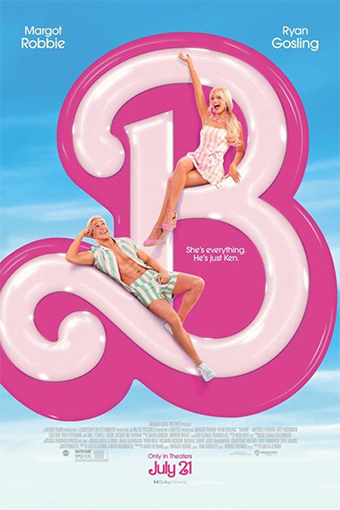 |
Director Greta Gerwig, along with her partner and co-writer Noah Baumbach, responded to a century of prejudicial portraits of women in cinema but swapping gender roles, in the process infuriating a whole slew of (primarily male) right-wing commentators, who only seem to acknowledge the very existence of sexism if its satirically directed at them. Above and beyond, that, this was close to being the most fun I had watching a movie all year (the film that topped it on this score, and on a tiny fraction of Barbie’s budget, is on the A List), as much for the care and imagination that went into every aspect of its production as its multi-faceted subtextual commentary on consumerism, gender roles, and even the impermanence of human existence. The production design is glorious, the performances a delight (how perfect is the casting of Margot Robbie and Ryan Gosling as Barbie and Ken?), and the I'm Just Ken song-and-dance number had me grinning like a cream-filled Cheshire cat. If there’s a downside, it’s that the film’s blockbuster summer success as half of the amusingly named Barbenheimer phenomenon means that we can expect a whole series of doubtless inferior films based around Mattel products in the next few years.
Film review [Camus] >>
Film review [Jerry Whyte] >>
DUNE: PART TWO
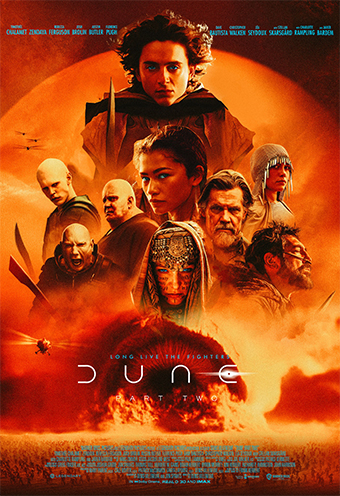 |
Denis Villeneuve follows up his rightly acclaimed adaptation of the Frank Herbert science fiction classic Dune – a film that told a complex and multi-stranded story in a grand and visually striking manner but with crystal clear clarity – with Part Two of a saga that I presume is going to be concluded in the upcoming Dune: Messiah. In isolation, Dune: Part Two is the most narratively incomplete of the three films, with its narrative beginning and concluding in the movies that bookend it, but on the evidence here, the storytelling, action, visual style and splendour will have a strong continuity throughout the three films. It’s an impressive watch, and the sound and picture on the 4K UHD are genuinely jaw-dropping, though I have a feeling that it’s at this point in the source novels that I my interest in finishing them started to fade, and that perhaps coloured my appreciation of what I still recognise as an extraordinary cinematic achievement. This is definitely one that I plan to watch again soon.
Film review [Camus] >>
ENYS MEN
In 1972, a woman voluntarily stationed on the small Cornish island of Enys Men embarks on a daily ritual that includes examining a small cluster of rare flowers, measuring the temperature of the earth, dropping a stone down a deep shaft, and recording her observations in a log book. Her only connection with the mainland is a two-way radio, which is located in in the isolated cottage in which she resides, its power supplied by a petrol-driven generator the woman that fires up each day after completing her rounds. Initially, it appears that she lives there alone, but it’s then suggested that she shares the cottage with a teenage girl that I presumed was her daughter. Or does she?
Mark Jenkins follows his arresting do-it-yourself debut Bait with a slow burn, folk horror-inflicted tale in which the linearity of time, at least for the unnamed central character, appears to have fractured, with the result that events of the past, present and future impact on each other in a manner that came close to scrambling my brain. Looking every inch (as fully intended) like a previously lost, low-budget, semi-experimental film from the early 1970s, Enys Men hints at so much without explicitly confirming a thing, but in the process builds an atmosphere of mystical unease that has haunted me ever since. This one definitely needs a couple of follow-up viewings.
Blu-ray review [Gary Couzens] >>
THE FIRST OMEN
Another series that really should have quit a couple of movies ago gets an unexpectedly impressive resurrection in the hands of first time feature director and co-writer Arkasha Stevenson. As the title suggests, this is a prequel to the original 1976 box-office smash, and follows American novice Margaret Daino as she arrives at Rome’s Vizzardeli Orphanage, where she gradually uncovers the dark secret that led to the events of The Omen.
Richly atmospheric and engrossingly paced and structured, it features a strong central performance from Nell Tiger Free as Margaret, and while it may tick a few of the expected tribute boxes (the willingly suicidal hanging from the first film is repeated and expanded on here), it generally stands on its own solid feet as one of the stronger horror works in what proved a rather good year for the genre. As genre fans will doubtless be aware, it was released within weeks of Immaculate, to which it has several key plot and character similarities, and I’ve not made my mind up yet which one I prefer, or whether the two films deserve to be treated as satanically sinister sisters of equal merit.
HIT MAN
What sounds from its utilitarian title like a companion piece to David Fincher’s The Killer (see below) is actually more its flipside, being an entertainingly light-hearted work whose lead character Gary is not a hit man at all, but a University of New Orleans professor whose way with electronics has landed him work with the city’s police department. In this role, he provides and monitors the equipment used in police stings set up to entrap individuals looking to commit murder by proxy by hiring a professional hitman, even though, Gary informs us, there is actually no such thing. When the undercover agent who poses as the hitman is suspended just as a sting is about to go down, Gary is hastily pushed into taking his place, and unexpectedly proves to have a natural talent for the role.
The latest from Slacker, Dazed and Confused and Boyhood director Richard Linklater is in some respects a lightweight confection, but it’s also a great deal of good-natured fun. The encounters between these would-be employers and the various personas that Gary uses to tailor himself to what he thinks they will expect of a professional assassin are a blast, and while there’s an inevitability to his sympathy for good-looking female client Madison, it’s refreshing that the two find themselves attracted to each because of their shared interests and humour rather than their facial features. Of course, we all know that Gary’s decision not to reveal who he really is to Madison will blow up in his face sooner or later, but by the time it does, a series of problematic complications have set in, which takes what transforms what begins a witty romantic comedy-drama into a blackly comic noirish thriller.
IMMACULATE
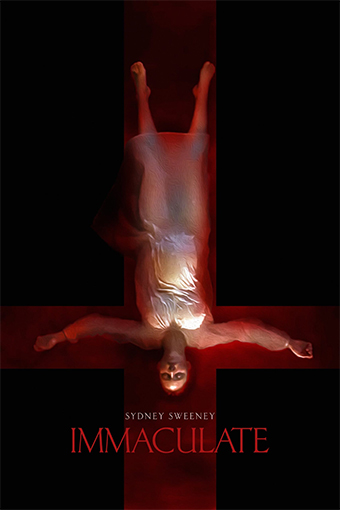 |
Devout young American Cecilia lands a place at an illustrious Italian convent, and soon starts to realise that there are dark deeds afoot within the cloisters. Sound familiar? Released just a couple of weeks before The First Omen, to which this film has some notable (and in all probability coincidental) similarities, this fifth feature from The Voyeurs director Michael Mohan shares with its sister film a steadily building sense of dread, which is aided considerably by Elisha Christian’s atmospheric cinematography and an ace central performance by Sidney Sweeney (a name you’ll be seeing again later). Despite my above noted uncertainty about which of the two films I prefer, if I was forced to choose (and why should I when I can have both?), I’d probably give the edge to Immaculate. This may be down in part to the fact that I saw it a couple of months before catching The First Omen, but by also not being part of a franchise, for me it also the purer of the two films, and its haunting, disturbing, primal scream ending really got under my skin.
I SAW THE TV GLOW
If I had to pick a film from this list that just demands at least a couple more viewings before I definitively make my mind up about it, director Jane Schoenbrun’s quietly mesmerising third feature, I Saw the TV Glow, would probably be it. It’s based around introspective young Owen, who strikes up a friendship with gay outsider Maddy over her passion for TV show titled The Pink Opaque, but the passing of years sees the two separate before unexpectedly being reunited in strange and troubling circumstances.
Glacially paced and performed in the lowest of keys, the film was nicely described by Time Out as “if David Lynch grew up obsessed with Buffy the Vampire Slayer,” its key strength being its eerie mood and atmosphere, and the disarming believability of the fragile friendship at its core. If you like your endings straightforwardly conclusive, however, the one delivered is likely to make your head rotate.
THE KILLER
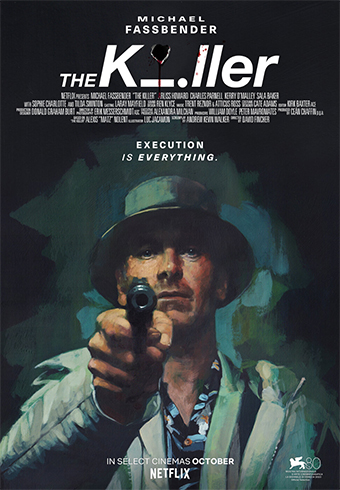 |
The carefully controlled world of an ice-cold professional hit man is disrupted when he misses his target and hits a bystander, the personal and professional consequences of which he is then forced to deal with. In the hands of Se7en and Sleepy Hollow screenwriter Andrew Kevin Walker and director David Fincher, this adaptation of the graphic novel series by Alexis 'Matz' Nolent and Luc Jacamon becomes a fascinating, darkly playful and blackly humorous portrait of an amoral killer with a Smiths obsession (always a bit worrying), and is a classic example of the notion that a character doesn’t have to be likeable to be interesting. A terrific cast headed by Michael Fassbender, a seriously brutal hand-to-hand combat sequence, and Fincher’s cooly observational approach and attention to detail mark this as one of Netflix’s best home-grown products of 2024. That said, I know I’m not the only one who really enjoyed the film but secretly wished they had given Fincher the money to make series three of Mindhunter instead.
LOVE LIES BLEEDING
Director and co-writer (with Weronika Tofilska) Rose Glass follows up the riveting Saint Maud with this hard-boiled blend of erotic thriller, gay romantic drama and neo-noir, built around two superb central performances by Kristen Stewart and Katy O'Brian. Stewart plays gym manager Lou, who finds herself attracted to female bodybuilder Jackie, who has left home and is heading to Las Vegas with the aim of competing in a regional bodybuilding championship. The two fall for each other become embroiled in a passionate relationship, but soon find themselves impacted and inadvertently caught up in the activities of Lou’s criminal family, whose head honcho is played by a grizzled and long-haired Ed Harris.
Another film that subsequent viewings may see bumped up to the A list, and while I do understand why it’s figured so highly on other picks of the year, I’m surprised that none of those I’ve so far read have even commented on the clear influence of the Wachowski siblings’ 1996 Bound, another tale of a passionate romance between two women whose relationship is impacted by the criminal activities of a male to whom one of them is directly connected. That shouldn’t take away from just how solidly structured, compellingly directed, and impressively acted Love Lies Bleeding is, and how refreshing it is to have a same-sex couple played by a gay bodybuilder and an openly bisexual actress.
REBEL RIDGE
After a duo of colour-titled masterworks in the shape of Blue Ruin and Green Room, writer-director Jeremy Saulnier shifts gear with a new take on the First Blood formula that pits an army veteran against a small town police chief who has a particular dislike of outsiders. The difference here is that former Marine, Terry Richmond, has come to the town in question to post bail for his cousin, and the hostility and obstructiveness he experiences at the hands of the local cops stems in no small part from the fact that he is black, while his refusal to back down leads to the uncovering of a web of corruption within the local law enforcement community.
A commanding performance from British actor Aaron Pierre as Richmond, a close to career best from Don Johnson as racist police chief Sandy Burnne, Saulnier’s expert direction, and some violent close combat confrontations that feel brutally real, make this a compelling, tense and ultimately satisfying watch.
SCALA!!! OR, THE INCREDIBLY STRANGE RISE AND FALL OF THE WORLD'S WILDEST CINEMA AND HOW IT INFLUENCED A MIXED-UP GENERATION OF WEIRDOS AND MISFITS
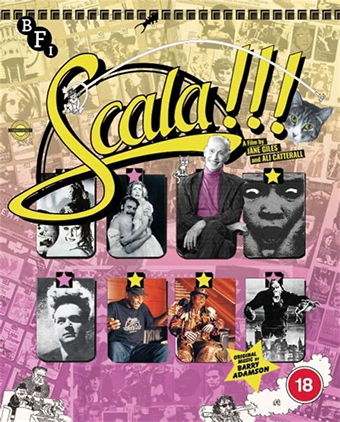 |
As one of those titular misfit weirdos who spent many, many hours of my late teens and early twenties at London’s Scala cinema in both its Tottenham Street and Pentonville Road locations, this was something of a dream watch for me. I loved the National Film Theatre, and regularly frequented London’s many other independent screens, but there was something about the Scala, its daily double-bills of perfectly matched and sublimely mismatched films, that made it one of my favourite haunts. It’s there that first saw Eraserhead (a film that genuinely changed my life), where I was first exposed to the films of Gerard Depardieu, and where I first caught George Romero’s The Crazies and Martin. I attended two festivals of rarely screened Laurel and Hardy films with my closest friend of the time, and saw Jack Arnold’s The Creature From the Black Lagoon and It Came From Outer Space in 3D with those cardboard glasses with their blue and red cellophane lenses. I traumatised myself with a double-bill of The War Game and Failsafe, then a week later lifted my spirits with the delicious pairing of It Happened One Night and The Philadelphia Story. The films themselves were a joy, but what really put a smile on my face was the girl further back in the auditorium who cried out as the film ended, “Oh, I want my life to be like that!”
The Scala was for years a mecca for fans of cult cinema, and as far as I’m aware was the only venue at which you could see an uncut print of Curt McDowell’s notorious underground hardcore black comedy Thundercrack! (1975). It was certainly the only place I saw Barbet Schroeder’s 1976 Maîtresse in its wince-inducing uncut form, at least until it was restored in 2003 (it’s now available in uncut on a BFI dual format release). Tragically, it all came to an end, somewhat ironically, at the hands of a cult movie when the cinema screened Stanley Kubrick’s then banned A Clockwork Orange (1971), and the fees that resulted from legal action by Warner Brothers contributed heavily to events that ended up putting this beloved cinema club out of business.
Then in 2021, a Kickstarter campaign was launched by Scala programmer and journalist Jane Giles that resulted in a huge and weighty but gloriously presented history of the cinema, one that rapidly went out of print but has now happily been re-issued. It’s a must-have for anyone who visited the cinema in its heyday, and I should state that my recommendation is in no way influenced by the fact that I am quoted in it. Giles followed this by teaming up with Ali Catterall for this lively documentary that mixes interviews with archive material to chronicle the history of the cinema and give a flavour of what a great place it was for film fans to hang out. That’s all you really need to know, save for the fact that it’s a film every true cineaste should see.
Blu-ray review [Gary Couzens] >>
TALK TO ME
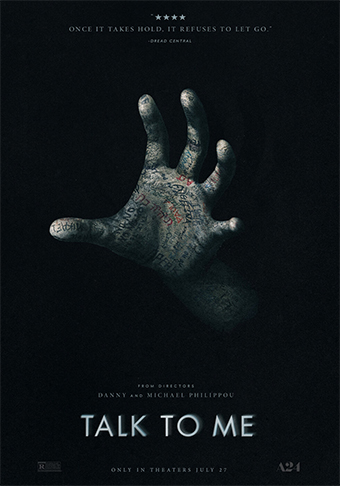 |
Several young people attend a house party in Adelaide whose principal attraction is the ceramic-encased and embalmed severed hand of a powerful medium, one that offers anyone who grasps it and says the words “talk to me” the opportunity to enter the spirit world and temporarily become the host to one of its occupants. At the start of the process, a candle is lit, and is blown out after 90 seconds to expunge the spiritual possessor and protect the sanity of the volunteer host. It’s a neat-enough concept for a horror film, but what really help sells it is the unhurried build-up to the first attempt at this supernatural party trick, which allows us to spend time getting to know characters who may not all be instantly likeable but feel far more authentic than the teen horror norm. That the hand-grasping process will work as rumoured is perhaps inevitable (it wouldn’t be much of a horror film if it didn’t), and the likelihood that it will eventually misfire in some as-yet uncertainly horrible manner is starkly signalled in the opening scene of violent murder and suicide at an altogether different house party.
In a solid cast, Sophie Wilde is a standout as 17-year-old Mia, who lost her mother Rhea to suicide two years earlier and who gets a serious jolt when one of the partygoers becomes possessed by Rhea’s spirit, which leads to disaster when the 90 second time limit is exceeded. Yet in terms of the consequences of meddling with the afterlife, we’re just getting started here. The social media age is openly embraced here (when the first partygoer is possessed, her companions are eagerly filming it on their mobile phones) and is reflective of the circumstances that led to the film being made, with brothers Danny and Michael Philippou first making their names with a string of inventive short films posted on their RackaRacka YouTube channel. Given the frenetic pace of many of these shorts, what impresses most about Talk to Me is how grounded it feels and how thoughtfully it’s paced, displaying a confidence the belies the directors’ first feature status.
Page 2: The A List >>
|